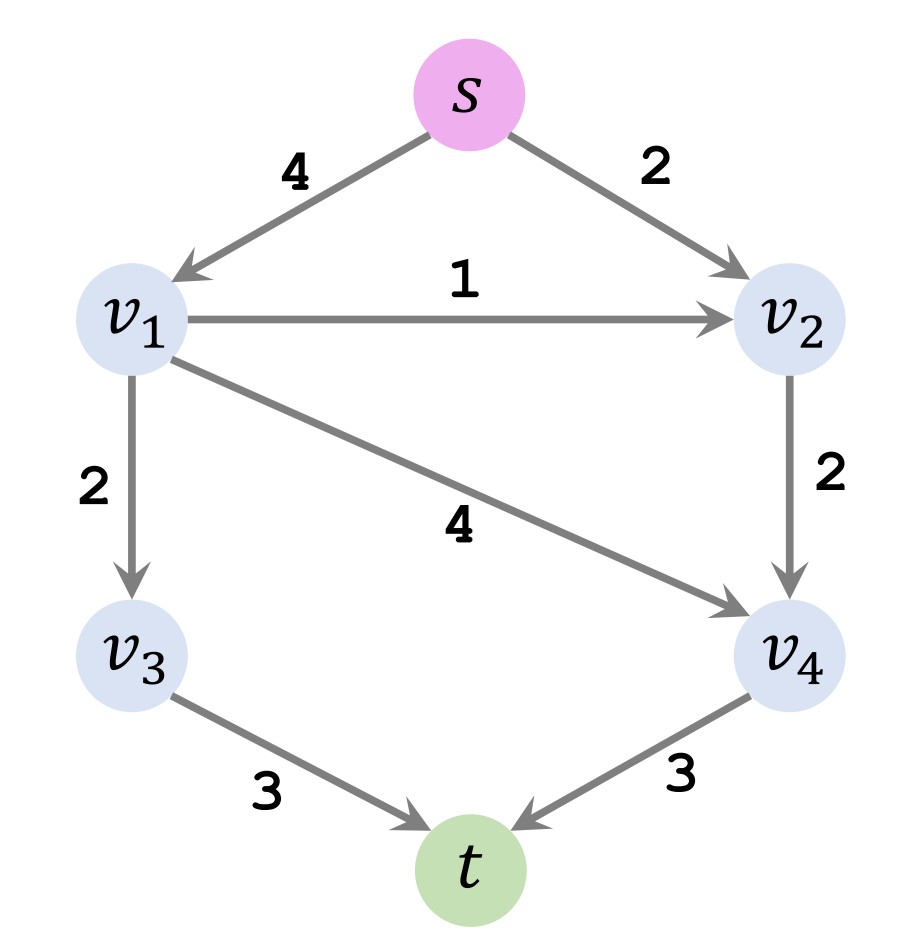参考:OI Wiki|王树深
名词:最大流,阻塞流
最大流一定是阻塞流,但是阻塞流不一定是最大流
m是边,n是节点,f为最大流的大小
Ford-Fulkerson Algorithm(算法复杂度$O(f\cdot m)$,依赖于最大流的大小)
key concept:residual graph
- 构造residual graph
- 寻找简单路径
- 取路径上residual最小的管道流量$p$作为路径上能通过的最大的流量,然后路径上每个管道都减去这个$p$
- 算法依次进行,直到找不到从$s$到$t$的简单路径
Edmonds-karp Algorithm(算法复杂度$O(m^2\cdot n)$,不依赖于最大流的大小)
key concept:residual graph
- 构造residual graph
- 寻找简单路径
- 取路径上residual最小的管道流量$p$作为路径上能通过的最大的流量,然后路径上每个管道都减去这个$p$
- 然后按照给这个路径上的管道都建一条反向的边,其流量为$p$
- 算法依次进行,直到找不到从$s$到$t$的简单路径

EK代码:
#include <bits/stdc++.h>
#include <iostream>
using namespace std;
#define maxn 250
#define INF 0x3f3f3f3f
struct Edge {
int from, to, cap, flow;
Edge(int u, int v, int c, int f) : from(u), to(v), cap(c), flow(f) {}
};
struct EK {
int n, m; // n:点数,m:边数
vector<Edge> edges; // edges:所有边的集合
vector<int> G[maxn]; // G:点 x -> x 的所有边在 edges 中的下标
int a[maxn], p[maxn]; // a:点 x -> BFS 过程中最近接近点 x 的边给它的最大流
// p:点 x -> BFS 过程中最近接近点 x 的边
void init(int n) {
for (int i = 0; i < n; i++) G[i].clear();
edges.clear();
}
void AddEdge(int from, int to, int cap) {
edges.push_back(Edge(from, to, cap, 0));
edges.push_back(Edge(to, from, 0, 0));
m = edges.size();
G[from].push_back(m - 2);
G[to].push_back(m - 1);
}
int Maxflow(int s, int t) {
int flow = 0;
for (;;) {
memset(a, 0, sizeof(a));
queue<int> Q;
Q.push(s);
a[s] = INF;
while (!Q.empty()) {
int x = Q.front();
Q.pop();
for (int i = 0; i < G[x].size(); i++) { // 遍历以 x 作为起点的边
Edge& e = edges[G[x][i]];
if (!a[e.to] && e.cap > e.flow) {
p[e.to] = G[x][i]; // G[x][i] 是最近接近点 e.to 的边
a[e.to] =
min(a[x], e.cap - e.flow); // 最近接近点 e.to 的边赋给它的流
Q.push(e.to);
}
}
if (a[t]) break; // 如果汇点接受到了流,就退出 BFS
}
if (!a[t])
break; // 如果汇点没有接受到流,说明源点和汇点不在同一个连通分量上
for (int u = t; u != s;
u = edges[p[u]].from) { // 通过 u 追寻 BFS 过程中 s -> t 的路径
edges[p[u]].flow += a[t]; // 增加路径上边的 flow 值
edges[p[u] ^ 1].flow -= a[t]; // 减小反向路径的 flow 值
}
flow += a[t];
}
return flow;
}
};
int main(){
cout << 3;
return 0;
}
Dinic‘s Algorithm(算法复杂度为$O(m\cdot n^2)$)
key concept:block flow、level graph
- 构造residual graph
- iteration
- 根据residual graph 构造level graph
- 在level graph上找阻塞流
- 用找到的阻塞流来更新residual graph,并在residual graph中建立反向边,其流量大小与阻塞流大小相同
最小割
求最小割问题就是求最大流问题,两者是等价的
Max-Flow Min-Cut Theorem

